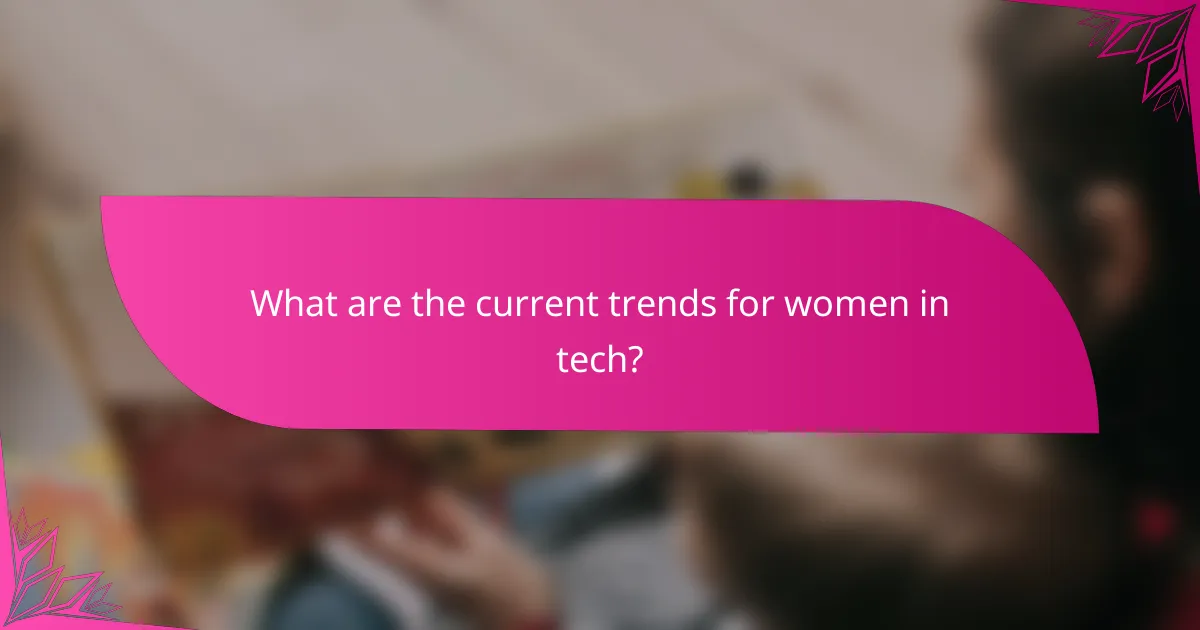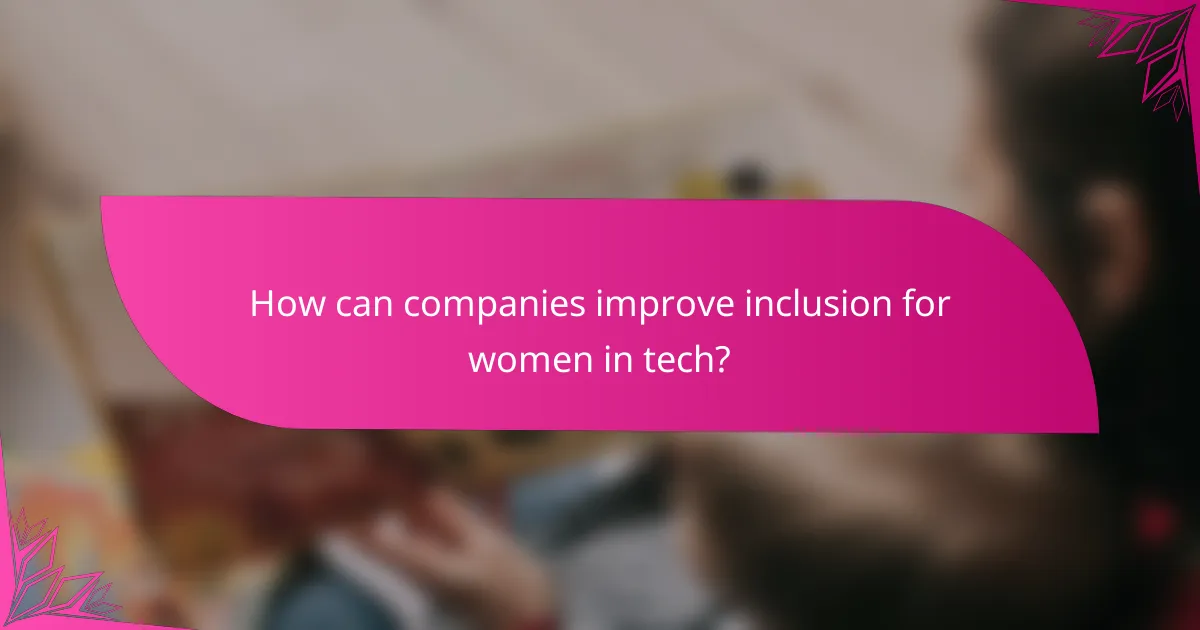The future of women in tech is increasingly promising, marked by significant advancements in representation and support systems. As the industry embraces diversity and inclusion, women are presented with a wealth of opportunities, including mentorship and networking, to propel their careers forward. By implementing targeted strategies, companies can foster an environment that values and empowers women, ensuring their growth and success in the technology sector.

What are the current trends for women in tech?
Current trends for women in tech highlight significant progress in representation, opportunities, and support systems. These trends reflect a growing commitment to inclusion and diversity within the technology sector.
Increased representation in leadership roles
Women are increasingly occupying leadership positions in tech companies, with many organizations prioritizing gender diversity in their hiring practices. This shift is driven by a recognition that diverse leadership teams can lead to better decision-making and innovation.
Companies like Salesforce and Microsoft have set ambitious goals for gender parity in leadership, often reporting on their progress publicly. This transparency encourages accountability and inspires other organizations to follow suit.
Growth of remote work opportunities
The rise of remote work has created more flexible job opportunities for women in tech, allowing them to balance professional and personal responsibilities more effectively. This flexibility can be especially beneficial for those with caregiving responsibilities.
Many tech companies are now offering fully remote or hybrid roles, which can help attract a more diverse talent pool. Women can leverage these opportunities to enter or advance in the tech field without the constraints of traditional office environments.
Focus on STEM education initiatives
There is a growing emphasis on STEM education initiatives aimed at encouraging young girls to pursue careers in technology. Programs that promote coding, robotics, and engineering skills are becoming more prevalent in schools and community organizations.
Organizations like Girls Who Code and Black Girls Code are actively working to bridge the gender gap in tech by providing resources, mentorship, and networking opportunities. These initiatives are crucial for fostering a new generation of female tech leaders.
Rise of women-led tech startups
Women-led tech startups are gaining traction, contributing to innovation and diversity in the industry. Female entrepreneurs are increasingly receiving funding and support from venture capitalists who recognize the value of diverse perspectives in business.
According to various reports, women-led startups often outperform their male counterparts in terms of return on investment. This trend encourages more women to pursue entrepreneurial ventures in the tech space, further enriching the ecosystem.

What opportunities exist for women in tech?
Women in tech have access to various opportunities that can enhance their careers, including mentorship programs, networking platforms, and scholarships for education. These resources aim to support women in overcoming barriers and advancing in the technology sector.
Access to mentorship programs
Mentorship programs provide women in tech with guidance from experienced professionals, helping them navigate their careers effectively. These programs often pair mentees with mentors who can offer insights, advice, and support tailored to their specific career goals.
To find a suitable mentorship program, consider looking for those that focus on your particular area of interest, whether it’s software development, cybersecurity, or data science. Many organizations, such as TechWomen and Women in Technology International, offer structured mentorship opportunities.
Networking platforms like Women Who Code
Networking platforms such as Women Who Code create spaces for women in tech to connect, share experiences, and collaborate on projects. These platforms often host events, workshops, and online forums that facilitate relationship-building among peers and industry leaders.
Joining these networks can lead to job opportunities, partnerships, and valuable industry insights. Engaging actively in these communities can significantly enhance your visibility and access to career advancement resources.
Scholarships for tech education
Scholarships specifically for women pursuing tech education can alleviate financial barriers and encourage more women to enter the field. Various organizations and educational institutions offer scholarships aimed at supporting female students in STEM disciplines.
When searching for scholarships, consider applying to programs like the Google Women Techmakers Scholarship or the Society of Women Engineers Scholarship. Many scholarships require a personal statement or project proposal, so be prepared to showcase your passion and commitment to technology.

How can companies improve inclusion for women in tech?
Companies can enhance inclusion for women in tech by adopting targeted strategies that address hiring practices, workplace culture, and flexible work options. These approaches create an environment where women feel valued and supported, ultimately leading to better retention and career advancement.
Implementing diversity hiring practices
Diversity hiring practices focus on attracting a varied talent pool, which includes women in tech roles. Companies can implement blind recruitment processes, use diverse interview panels, and actively seek candidates from underrepresented backgrounds to ensure a fair selection process.
It’s beneficial to set specific diversity goals, such as aiming for a certain percentage of women in technical roles. Regularly reviewing hiring metrics can help identify gaps and adjust strategies accordingly.
Creating inclusive workplace cultures
An inclusive workplace culture fosters respect and collaboration among all employees. Companies can promote this by providing diversity training, encouraging open dialogue about gender issues, and establishing mentorship programs specifically for women in tech.
Recognizing and celebrating achievements of women in the workplace can also enhance morale and visibility. Regular feedback sessions can help ensure that all voices are heard and valued.
Offering flexible work arrangements
Flexible work arrangements, such as remote work options and adjustable hours, can significantly improve job satisfaction for women in tech. These arrangements allow for better work-life balance, which is crucial for many employees managing personal responsibilities.
Companies should consider implementing policies that support part-time work or job sharing. Providing the necessary tools for remote collaboration can also ensure that all employees remain connected and productive, regardless of their work location.

What are the barriers women face in tech?
Women in tech encounter several barriers that hinder their progress and participation in the industry. These obstacles include gender bias in hiring, a lack of female role models, and challenges in maintaining a work-life balance.
Gender bias in hiring processes
Gender bias in hiring processes often manifests through unconscious stereotypes that favor male candidates. This bias can lead to women being overlooked for roles or receiving lower salaries compared to their male counterparts with similar qualifications.
To combat this, companies can implement blind recruitment practices, where identifying information is removed from applications. Additionally, training hiring managers on bias awareness can help create a more equitable hiring environment.
Lack of female role models
The absence of female role models in tech can discourage women from pursuing careers in this field. When women do not see others like them in leadership or technical positions, they may feel isolated or question their ability to succeed.
Organizations can address this by promoting female leaders and creating mentorship programs that connect aspiring women in tech with established professionals. Highlighting success stories of women in tech can also inspire others to follow similar paths.
Work-life balance challenges
Work-life balance challenges are significant barriers for women in tech, often exacerbated by demanding work hours and the expectation to be constantly available. This can lead to burnout and a higher likelihood of women leaving the workforce.
Employers can support work-life balance by offering flexible work arrangements, such as remote work options and flexible hours. Encouraging a culture that respects personal time and promotes mental health can also help retain female talent in the tech industry.

How does the tech industry compare globally for women?
The tech industry shows significant variation in women’s representation across different countries. While some nations have made strides in promoting gender equality in technology roles, others still face challenges in achieving balanced workforce participation.
Leading countries in women tech workforce
Countries like the United States, Canada, and several Nordic nations lead in terms of women’s participation in the tech workforce. In these regions, women hold around 25-30% of tech jobs, benefiting from supportive policies and initiatives aimed at increasing diversity.
In contrast, countries such as Japan and South Korea have lower percentages, often below 15%. Cultural norms and workplace structures in these nations can hinder women’s entry and advancement in technology fields.
To improve representation, countries are increasingly adopting measures such as mentorship programs, flexible work arrangements, and educational initiatives targeting young women interested in STEM fields. These efforts aim to create a more inclusive environment that encourages women to pursue careers in technology.


